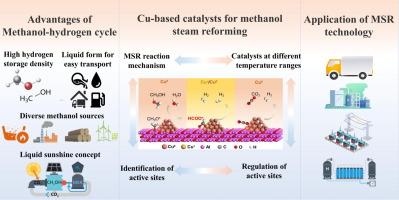Advances in Cu-based catalysts for methanol steam reforming: Mechanistic insights and atomic-level design
IF 14.9
1区 化学
Q1 Energy
引用次数: 0
Abstract
Methanol steam reforming (MSR) represents a promising route for hydrogen production, leveraging the high energy density and liquid-phase storage advantages of methanol. Copper-based catalysts have become indispensable for MSR due to their cost-effectiveness, exceptional catalytic activity, and tunable selectivity. However, persistent challenges such as thermal sintering, undesirable CO byproduct formation, diminished low-temperature reactivity, and long-term catalyst deactivation limit their broad industrial deployment. This review comprehensively examines the mechanistic pathways of MSR over Cu-based catalysts, with particular focus on differentiating catalyst formulations optimized for high-temperature (>200 °C) versus low-temperature (<200 °C) operation. It highlights the decisive influence of Cu nanoparticle size, electronic structure, and crystal structure on catalytic performance. Cutting-edge design strategies, including multi-element engineering, innovative synthesis techniques, and deactivation mitigation, are critically evaluated to elucidate mechanistic connections between atomic-scale structure and catalytic performance enhancement. Finally, industrial applications of commercial Cu/ZnO/Al2O3 variants and their scalability challenges are discussed, alongside prospective strategies for catalyst innovation and engineering to advance next-generation hydrogen production.

甲醇蒸汽重整用cu基催化剂的研究进展:机理和原子水平设计
甲醇蒸汽重整(MSR)利用甲醇的高能量密度和液相储存优势,是一种很有前途的制氢途径。铜基催化剂因其成本效益、优异的催化活性和可调的选择性而成为MSR中不可或缺的催化剂。然而,诸如热烧结、不良CO副产物形成、低温反应性降低以及长期催化剂失活等持续存在的挑战限制了其在工业上的广泛应用。本文全面研究了铜基催化剂上MSR的机理途径,特别关注了高温(200°C)和低温(200°C)操作下催化剂配方的优化。它强调了铜纳米颗粒尺寸、电子结构和晶体结构对催化性能的决定性影响。尖端的设计策略,包括多元素工程、创新的合成技术和失活缓解,被严格评估,以阐明原子尺度结构和催化性能增强之间的机制联系。最后,讨论了Cu/ZnO/Al2O3商用变体的工业应用及其可扩展性挑战,以及催化剂创新和工程的前瞻性策略,以推进下一代氢气生产。
本文章由计算机程序翻译,如有差异,请以英文原文为准。
求助全文
约1分钟内获得全文
求助全文
来源期刊

Journal of Energy Chemistry
CHEMISTRY, APPLIED-CHEMISTRY, PHYSICAL
CiteScore
19.10
自引率
8.40%
发文量
3631
审稿时长
15 days
期刊介绍:
The Journal of Energy Chemistry, the official publication of Science Press and the Dalian Institute of Chemical Physics, Chinese Academy of Sciences, serves as a platform for reporting creative research and innovative applications in energy chemistry. It mainly reports on creative researches and innovative applications of chemical conversions of fossil energy, carbon dioxide, electrochemical energy and hydrogen energy, as well as the conversions of biomass and solar energy related with chemical issues to promote academic exchanges in the field of energy chemistry and to accelerate the exploration, research and development of energy science and technologies.
This journal focuses on original research papers covering various topics within energy chemistry worldwide, including:
Optimized utilization of fossil energy
Hydrogen energy
Conversion and storage of electrochemical energy
Capture, storage, and chemical conversion of carbon dioxide
Materials and nanotechnologies for energy conversion and storage
Chemistry in biomass conversion
Chemistry in the utilization of solar energy
 求助内容:
求助内容: 应助结果提醒方式:
应助结果提醒方式:


